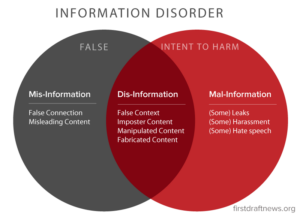More cures for fake news?
Chris Sutcliffe posted last week about the Truth Spectrum summit, and the various approaches media businesses can take to counter the tide and impact of “fake news.”

Coincidentally, Claire Wardle – who hates the term “fake news“, so I hope will accept my apologies for the title of this blog – last week published an exhaustive study on the phenomenon for the Council of Europe with Hossein Derakshan. Wardle instead prefers the terms “information pollution” or “information disorder” to describe the trend, arguing, among other things, that the term ‘fake news’ has now become corrupted by politicians who use it as a whip to beat legitimate but oppositional media. She also argues, persuasively, that the phrase tends to draw focus to text-based information, where there is equal or greater potential damage done by falsified or misleading images.
Wardle and Derakshan identify three types of information disorder: mis-information, dis-information, and mal-information (see diagram above). Of these, dis-information is the closest to what people mean when they discuss ‘fake news’ – the pernicious spreading of deliberately false information with the intention to harm. The document goes into forensic detail on a number of prime examples, and examines the life-cycle of the content – from creation to reproduction to distribution – and the motivations of people who create, spread and interpret the articles.
These elements are critical, becauseit is in the distribution and reproduction of articles that technology and media businesses can make a real difference, Wardle and Derakshan argue. Their report concludes with 35 different recommendations for those involved in the information chain (from technology companies, to governments and civil society). It is worth outlining their recommendations for media companies here, with the hope that people should take the time to read the full report in more depth.
“What could media organisations do [to counter information pollution]?
“1. Collaborate. It makes little sense to have journalists at different news organisations fact-checking the same claims or debunking the same visual content. When it comes to debunking mis- or dis-information, there should be no ‘scoop’ or ‘exclusive’. Thus, we argue that newsrooms and fact-checking organisations should collaborate to prevent duplications of effort and free journalists to focus on other investigations.
“2. Agree policies on strategic silence. News organisations should work on best practices for avoiding being manipulated by those who want to amplify mal- or dis-information.
“3. Ensure strong ethical standards across all media. News organizations have been known to sensationalize headlines on Facebook in ways that wouldn’t be accepted on their own websites. News organizations should enforce the same content standards, irrespective of where their content is placed.
“4. Debunk sources as well as content. News organisations are getting better at factchecking and debunking rumours and visual content, but they must also learn to track the sources behind a piece of content in real time. When content is being pushed out by bot networks, or loose organised groups of people with an agenda, news organisations should identifying this as quickly as possible. This will require journalists to have computer programming expertise.
“5. Produce more segments and features about critical information consumption. The news media should produce more segments and features which teach audiences how to be critical of content they consume. When they write debunks, they should explain to the audience how the process of verification was undertaken.
“6. Tell stories about the scale and threat posed by information disorder. News and media organisations have a responsibility to educate audiences about the scale of information pollution worldwide, and the implications society faces because of it, in terms of undermining trust in institutions, threatening democratic principles, inflaming divisions based on nationalism, religion, ethnicity, race, class, sexuality or gender.
“7. Focus on improving the quality of headlines. User behaviour shows the patterns by which people skim headlines via social networks without clicking through to the whole article. It therefore places greater responsibility on news outlets to write headlines with care. Research using natural language processing techniques are starting to automatically assess whether headlines are overstating the evidence available in the text of the article. This might prevent some of the more irresponsible headlines from appearing.
“8. Don’t disseminate fabricated content. News organisations need to improve standards around publishing and broadcasting information and content sourced from the social web. There is also a responsibility to ensure appropriate use of headlines, visuals, captions and statistics in news output. Clickbait headlines, the misleading use of statistics, unattributed quotes are all adding to the polluted information ecosystem.”
These are big challenges for the media industry, and would require a wholesale change in the way it thinks. But maybe the growing realisation that information pollution could pose an existential threat to them might just prompt responsible media businesses to behave as Wardle and Derakshan hope.